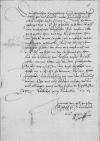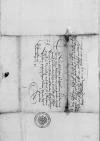Letter #5272
Ioannes DANTISCUS to Albrecht I von Hohenzollern-AnsbachHeilsberg (Lidzbark Warmiński), 1541-11-16
| received 1541-11-19 Manuscript sources:
Auxiliary sources:
Prints:
| ||||||||||
Text & apparatus & commentaryPlain textText & commentaryText & apparatus
Dem durchlauchten, hochgebornen fursten und herren, hern
Durchlauchter, hochgeborner furst, hochgunstiger(r), lieber her und freundt. / Unsere freuntliche unnd vleiss willige dinste zuvorn. /
Wir habenn gestrigs tags E(wer) F(urstlichen) D(urchlauch)t cf.
Dat(um)
ma(n)u p(ro)pria s(ub)s(cripsi)t



 GStA PK, HBA, C1 No 807, 4v
GStA PK, HBA, C1 No 807, 4v